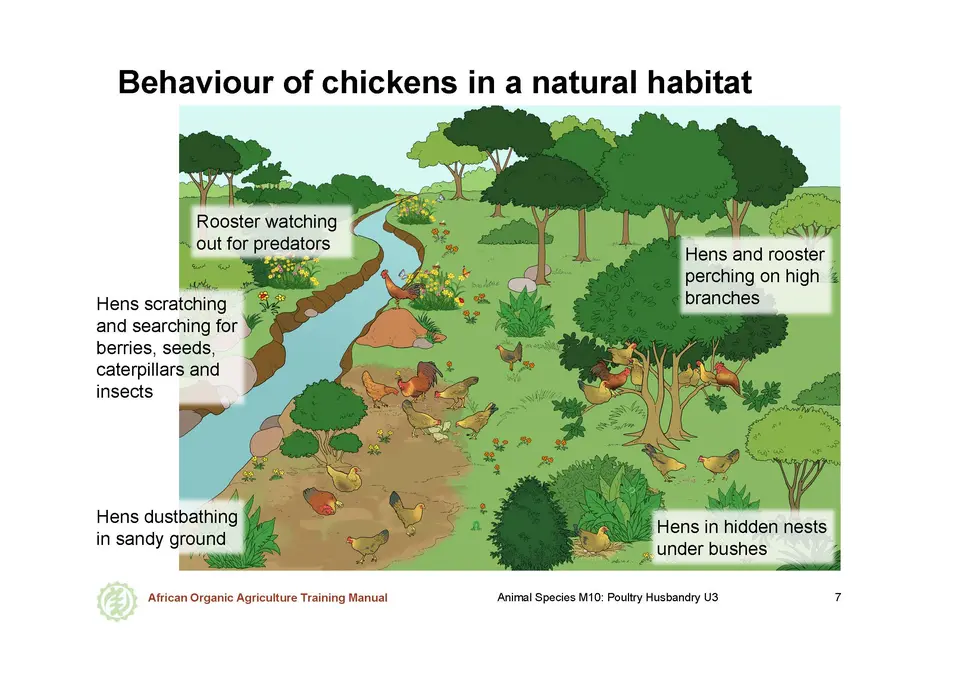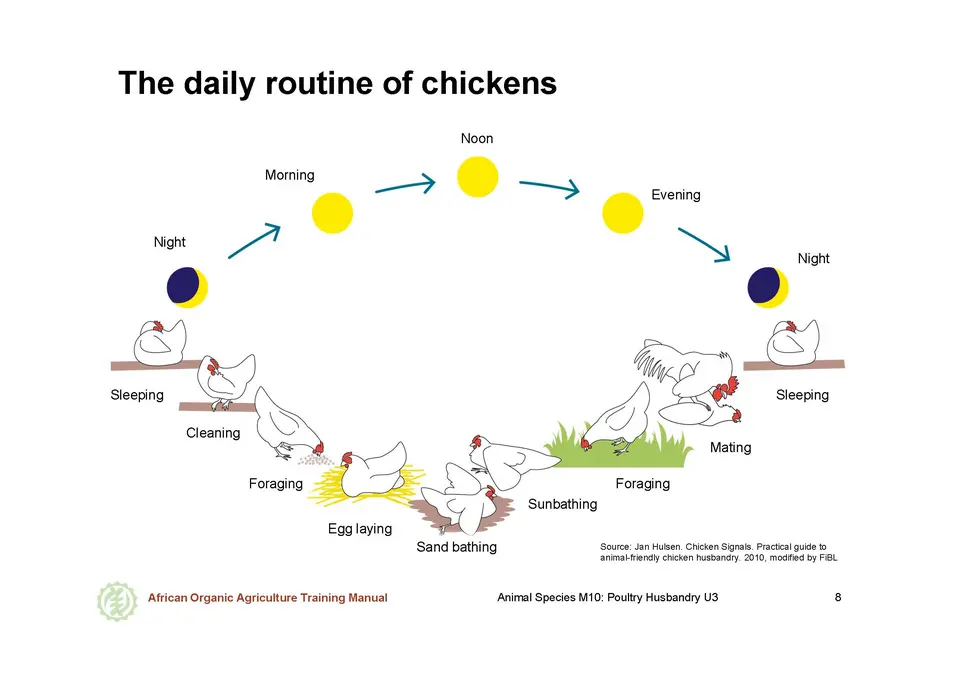Chicken behaviour
Importance of natural behaviour
Chickens, like other domesticated animals, have a number of natural behaviours. If they are not allowed to show these behaviours, they may suffer from stress and poor health, and may develop behavioural disorders such as feather pecking and cannibalism. This is why animals in an organic system must be kept in such a way that they can demonstrate their natural behaviours. This means that housing systems, feeding, and handling in an organic system are adapted to the needs of the animals. Therefore, it is important to know some details about normal chicken behaviour.
Social organisation
When allowed to practice their natural behaviours, chickens live in small flocks consisting of one or a few roosters and several hens. The chickens know each other individually and they have a hierarchy. One rooster normally has the leading position in the flock. Besides the insemination of the hens the rooster also guides and protects the hens, and may also settle disputes between the hens. Therefore, a few roosters should be integrated into flocks of laying hens even if breeding is not desired. In this case, it is best when the hens and the rooster are raised together or the roosters are older and experienced, as the hens are so superior in number. In this way, they can establish their natural hierarchy. A young rooster introduced later may not be respected by the hens and may be pecked.
Recommendation on roosters: Raise and keep roosters with the flock. As a general guideline, 1 rooster for up to 50 hens is considered suitable. For larger groups, 1 rooster for every 100 hens is appropriate. In case of on-farm breeding, more roosters are needed to inseminate all eggs. In agile breeds 1 rooster for 5 to 15 hens, in heavier breeds 1 rooster for 5 to 10 hens is then needed.
Pecking
Chickens start the day with exploration of their environment and scratching for feed. Under natural conditions, they spend approximately half of the day searching for feed and eating. If chickens are confined and unable to perform this behaviour, they will start searching for feed on each other. They will peck each other’s feathers, skin, toes or other body parts, which can result in severe injuries or even death. Over time, this will become a learned behaviour, and can cause severe losses in a flock.
Recommendation on scratching material: In semi-intensive systems, straw litter or an equivalent material needs to be added to the housing system to supply the demand of this behaviour.
Nesting
In nature, hens build a nest in a protected place, padded with grass, hay or other soft material. If farmers want the hens to be good layers they should construct nests that fulfil the demands of the hens.
Recommendation on nesting material: Natural nesting conditions can be imitated by constructing nests that are placed in quiet, shadowed places with the bottom covered with soft material like straw, husks, or rubber nubs.
Sheltered foraging
Chickens prefer to forage in a pasture where they can easily find shelter from the weather and protection from predators under trees and shrubs. If no shelter is offered, the animals might not be willing to use the pasture, but instead stay close to their hen house and overuse this area.
Recommendation: To protect existing and/or newly planted shrubs or trees in the pasture area, they can be fenced-in. Covered dustbaths can serve as artificial shelters.
Plumage grooming
Plumage grooming also is an important element of the behavioural repertoire of chickens, and is important for their health and productivity. Chickens care for their feathers while greasing them with the fat of the preen gland. They also care for their feathers by taking a bath in dust and sunbathing. The dust removes old fat and also helps to eliminate parasites (such as mites), and the sunlight reduces bacteria in the coat. Additionally, the sunlight is essential for the synthesis of Vitamin D which is important for the construction of healthy bones and strong eggs.
Recommendation: Install areas with sand or dry earth and provide access to sunlight in the outdoor pasture. Covered boxes filled with sand provide artificial shelters and dustbaths in one.
Resting
To feel safe when resting and sleeping during the daytime or sleeping during nighttime, chickens look for higher spots (e. g. trees). They also avoid conflicts by moving to a higher or lower perch. Chickens should also have the possibility to satisfy this need inside the hen house.
Recommendation: Install perches with different levels in the henhouse, with enough space for each bird.
If the above-mentioned needs are respected, the free-range (or extensive system) as well as the semi-intensive system can be adapted for organic chicken production.
Group discussion on natural behaviour of poultry
Ask the farmers the following questions and discuss with them the answers:
- What similarities and differences do you see between the natural habitat and the different production systems?
- What benefits can be realised if natural chicken behaviours are understood and respected?
- What challenges can arise if they are not?


 tap and then scroll down to the Add to Home Screen command.
tap and then scroll down to the Add to Home Screen command.